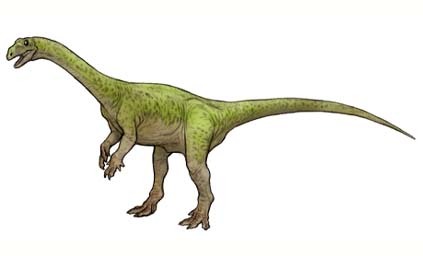palaeopedia:The large vertebrae, Massospondylus (1854)Phylum : ChordataClass : ReptiliaOrd
palaeopedia:The large vertebrae, Massospondylus (1854)Phylum : ChordataClass : ReptiliaOrder : SaurischiaSuborder : SauropodomorphaFamily : MassospondylidaeGenus : MassospondylusSpecies : M. carinatus, M. kaalaeEarly Jurassic (201,3 - 182,7 Ma)4 m long and 130 kg (size)Upper Elliot formation, South Africa (map)Massospondylus is a good example of the class of dinosaurs known as prosauropods—small-to-medium sized, small-brained herbivores of the early Jurassic period whose relatives later evolved into towering sauropods like Barosaurus and Brachiosaurus. In early 2012, Massospondylus made headlines thanks to the discovery in South Africa of preserved nesting grounds, containing fossilized eggs and embryos, dating to the early Jurassic period (about 190 million years ago)This plant-eater—which paleontologists believe stomped in stampede-sized numbers across the plains of early Jurassic South Africa—is also a case study in changing views of dinosaur behavior. For decades, it was widely believed that Massospondylus walked on all fours, only occasionally rearing up on its hind legs to reach vegetation. In the last few years, though, convincing evidence has come to light that Massospondylus was primarily bipedal, and faster (and more agile) than was previously believed.Because it was discovered so early in paleontological history—in 1854, by the famous naturalist Sir Richard Owen—Massospondylus has generated its share of confusion, as various fossil remains have been incorrectly assigned to this genus. For instance, this dinosaur has been identified (at one time or another) with such dubious and now-discarded names as Aristosaurus, Dromicosaurus, Gryponyx, Hortalotarsus, Leptospondylus, and Pachyspondylus. -- source link
Tumblr Blog : palaeopedia.tumblr.com
